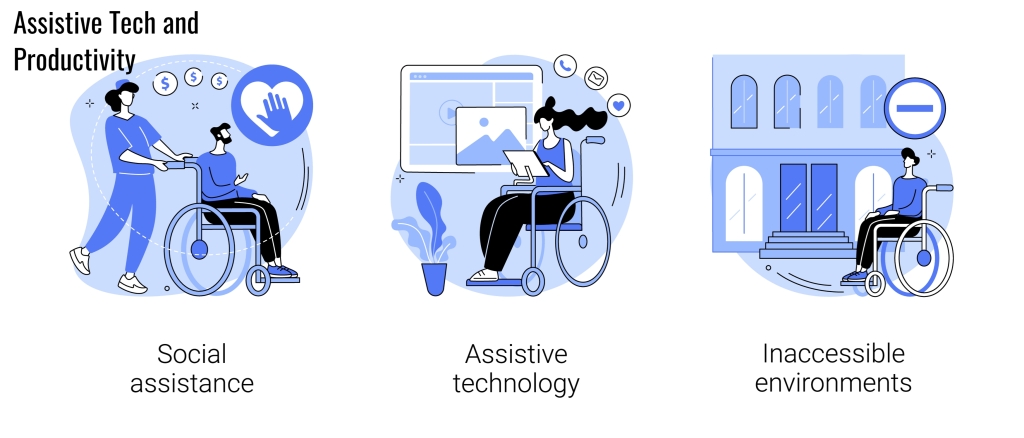Listen on Spotify.
Technology surrounds us all. Not least in the workplace. You might think assistive technology (AT) is something that’s mostly used by people with disabilities, but if you’ve so much as asked Alexa what the time is, you’ve used AT.
Assistive technology first came into the workplace to help make our working lives easier and — at least in theory — help us produce more whilst expending less effort. Soon, the reach of it extended to include our homes to enhance our lives, something I touched on in an earlier post about the history of productivity.
I thought it high time to bring the focus back to the workplace again and see how assistive tech can improve both our efficiency and the quality of our working lives nowadays.
Later, I’ll talk about how AT can help people with and without disabilities be as productive as they can be. First, though, let’s get down to it and define assistive technology.

What’s assistive technology?
Assistive technology is equipment, software, or other devices which help people function and participate more fully in society. These aids are typically designed to ease learning, communication, and movement.
Types of assistive technology: What can they do?
As far as I’ve been able to make out, AT for work is split into three main categories. Office, non-office, and accessibility. Here, I’ve broken each of them down for you as best I can.
Office
- Speech recognition software
- This works when you speak into a microphone and the words you speak appear on your screen.
- You can get your ideas down fast, without worrying too much about spelling or typing.
- For more on speech recognition software and how it can help increase your productivity, you can refer to my post on dictation software.
- Text to Speech
- This software reads digital text out to users.
- It allows emails, webpages, Word and PDF documents to be read aloud, directly or through headphones.
- This may be of particular use to you if you have difficulty reading, or struggle to fully engage with on-screen text.
- Popular examples include ClaroRead and Natural Reader.
- There’re screen readers which have been specifically designed to help those with visual impairments. Two of the providers of these are Supernova and NVA.
- Taking notes and mind mapping
- Note-taking can be more challenging for some people.
- There’re multiple ways you can use tech to tackle this. The most popular examples include Notability, Evernote and Sonocent Recorder.
- There’s also an abundance of software to help you brainstorm your ideas. It lets you represent ideas using colours, shapes and symbols to help you plan things. Inspiration is a popular example of this kind of software.
- There’s also a good range of aids specifically for the hearing impaired, including table microphones, hearing aids that are compatible with telephone headsets and radio aid bundles for work. Getting access to Video Relay Service (VRS) is easier than ever before in the UK.
Non-Office
If you don’t aspire to have an office job, there’re adapted tools available to help level the playing field.
- Hand tools designed to allow you to get a really good grip.
- Modifications made to a work vehicle, even vehicles you might not think of, like tractors. You can get modifications to the steering wheel of vehicles to aid grip and steering.
Accessibility
- Building access. This includes ramps, lifts, automatic doors and anything else that makes it easier — or indeed possible in the first place — to enter a building and get to where you need to be within that building.
- Adapted bathrooms. Every possible aid should be added to bathrooms, such as railings and alarms, plus easily reachable loo roll holders and sinks. Wherever a space can be feasibly used as, or converted to a disabled toilet, a concerted attempt should be made to do so.
Shortly, I’ll go into more detail about how assistive tech can help people with various disabilities. Next though, I’ll talk about a good funding scheme the government set up to give incentive to employees to hire disabled people and to make it easier for us to get access to the support we need to do our jobs well and efficiently. As with many other things in life, you often need both opportunity and money to have the best chance of being both happy and productive at work.
Funding and Access to Workplaces
Access to Work has been set up by the UK Government in order to help more disabled people get into the workplace. This funding will generally cover essential assistive technology based on your needs and the existing conditions of your place of work. For example, you’re unlikely to need access to a lift, in a ground-floor office, if accessible toilets and all the rooms in which you may need to meet with colleagues in are all on the same floor.
This scheme helps the employers among you bring AT into the workplace. The funding can also be used to make workplace adaptations, such as transport to and from work, and support on-site. From an interpreter, for instance.
Employees will need to pay a fee to unlock the benefits of this great scheme. But when you do, you will have taken a huge step towards making the job opportunities you offer more attractive to those with disabilities and those without. If you’d like me to devote a whole post to a deep dive into this scheme, leave a comment to let me know.
Now it’s time to talk more specifically about AT and efficiency.

What can AT for work do for productivity?
Here, it seemed most helpful to categorise by disability type in the interests of clarity. I’ve done my best to pick the main aids for each category, but there’re many more aids available than those I’ve listed — indeed, there’re many more categories.
Sight loss
- Screen magnifiers make it easier for you to be productive because — by using the various options for enhanced text smoothing and highlighting, and colour contrast — it should be easier to type and navigate the screen without losing your place. Much of the software is compatible with different operational systems, like Windows, allowing for good flexibility too. You can use it to improve team efficiency as well, perhaps when putting together presentations.
- Text to speech is a huge help to those who have progressive sight loss, where your vision can vary throughout the day. It can be turned on and off so that you’ll more likely to be able to maintain constant productivity levels throughout the day.
- Braille displays make it possible for employees who are blind to read and write in Braille. On-screen text is relayed through refreshable cells, so, as users move down the page the lines are converted to Braille, further boosting the productivity of teams and individuals.
Hearing Loss
- Having a translation and captioning system that works is essential if people with hearing loss are to be as efficient as they can be. After all, if you’re unable to follow an online meeting because the captions are inaccurate, how can you be truly productive? There is also Sunglass technology that’s designed to help you keep track of what’s being said in work meetings, by providing an image of the interpreter and a way to record meetings, without stress, so that you can learn to work at your own pace and improve your productivity.
- Speak and See microphones are fab for in-person group meetings of up to 9 people. Each person’s microphone lights up in a different colour when they’re speaking. These don’t pick up background noise and have good accuracy. Sounds like a good way to improve team efficiency in my book.
- UbiDuo 3 is breaking down communication barriers amongst the hearing loss community. It’s an easily portable, lightweight device that allows for easy face-to-face interaction between people who have hearing loss and those who don’t. It gives uses an immediate response, so that you can see what the person without hearing loss is saying without embarrassing pauses. This is super for your mental wellbeing and saves time, and saving time means you’re being more efficient.
Motor Skills
The range of disabilities you can have which entail problems with motor skills is vast and impossible to cover fully and concisely here. Thus, I’ve picked out the main AT designed to help in this area.
- Head wands and mouth sticks are designed to help people with very limited mobility. Mouth sticks allow people with no use of their hands to use their mouth to work a keyboard and maybe a trackball mouse, depending on the degree of patience and control you have. Head wands work on the same principle as mouth sticks, but you wear them with a headband so that you can have greater control of the stick when you move your head. This may help you get more done.
- You can use an adaptive keyboard to help you if you can’t make precise movements with your hands. If you suffer from tremors, or other uncontrollable movements, this type of keyboard may prove particularly useful. Some have raised keys and lowered areas. If you have a standard keyboard, you can get keyboard overlays that do the same job for you.
- Devices that use eye-tracking can be a fantastic alternative for those with no control over the movement of their hands. But this tech can be pricey and eye-tracking devices are therefore less common than head wands and mouth sticks.
Summary
We’ve covered what AT is, what it may be used for and how it can help increase or sustain your productivity levels whether or not you happen to have a disability. I hope this has given you the confidence to explore this further. There’s more assistive tech out there than I could hope to cover in one post. Why not do a search to find the best options for you today? Soon, you’ll be showing the world exactly what you’re made of!

I am impressed with this website , real I am a big fan .
LikeLike
Thank you. 😀
LikeLike
I love it whenever people get together and share opinions. Great website, stick with it!
LikeLike
Thanks! That’s very generous of you. Sorry it took a while for me to reply, I’ve just found your comment in the spam folder. Thanks again for reading.
LikeLike
Spot on with this write-up, I truly think this web site needs much more consideration. I’ll probably be again to learn much more, thanks for that info.
LikeLike
Thank you 😀
LikeLike